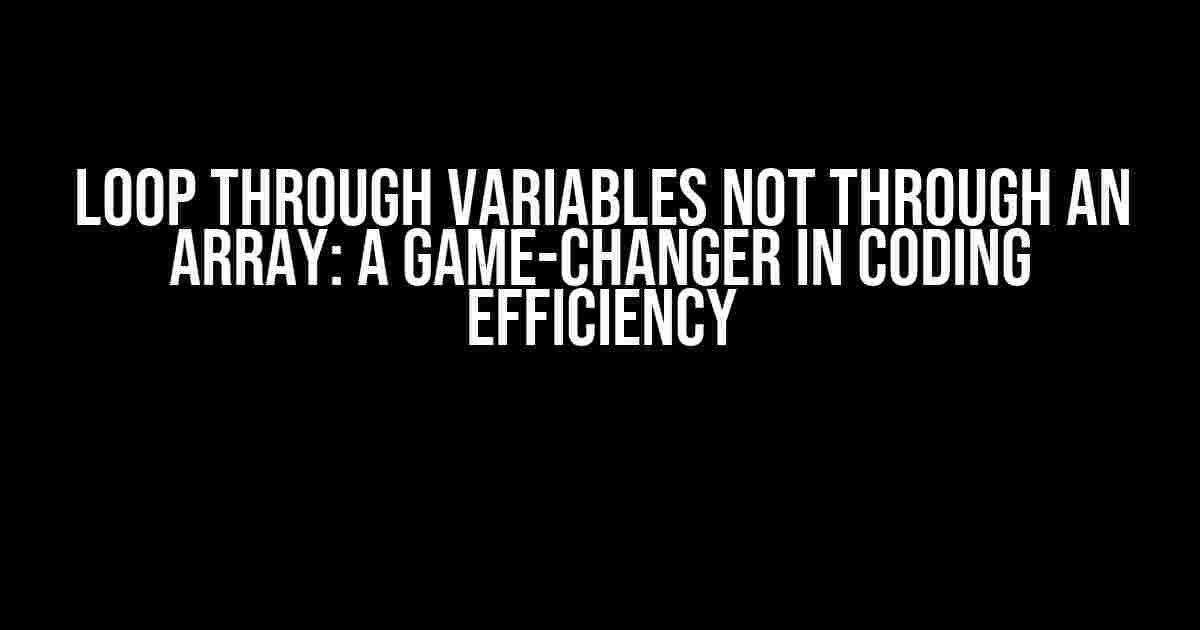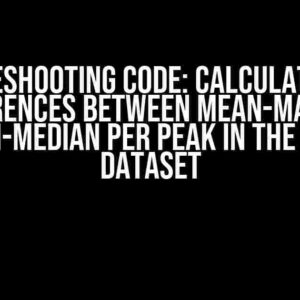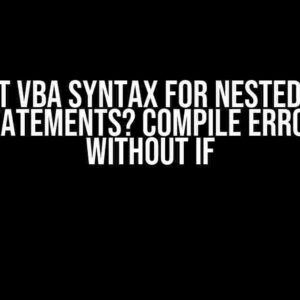When it comes to coding, efficiency is key. One of the most common practices in programming is looping through arrays to perform tasks on each element. However, what if we told you there’s a better way to do it? In this article, we’ll explore the concept of looping through variables, not through an array, and how it can revolutionize the way you code.
Why Loop through Variables?
So, why would you want to loop through variables instead of an array? Well, for starters, it can make your code more efficient and readable. When you loop through an array, you’re essentially creating a temporary variable to store the value of each element, which can be wasteful. By looping through variables, you can skip this step and directly access the values you need.
Moreover, looping through variables can also help reduce the complexity of your code. Imagine having to write multiple loops to perform different tasks on each element of an array. With variable looping, you can consolidate these tasks into a single loop, making your code more concise and easier to maintain.
The Basics of Variable Looping
Before we dive deeper, let’s cover the basics of variable looping. In essence, variable looping involves using a loop to iterate through a set of variables, rather than an array. This can be achieved using a variety of programming languages, including JavaScript, Python, and PHP.
The simplest way to loop through variables is by using a for-in loop. Here’s an example in JavaScript:
let var1 = 1;
let var2 = 2;
let var3 = 3;
for (let variable in {var1, var2, var3}) {
console.log(variable);
}This code will output the values of each variable, one at a time. Note that the “in” keyword is used to specify the variables to loop through.
Advanced Variable Looping Techniques
Now that we’ve covered the basics, let’s explore some advanced techniques for looping through variables.
Using Object Properties as Variables
In JavaScript, you can use object properties as variables to loop through. Here’s an example:
let obj = {
var1: 1,
var2: 2,
var3: 3
};
for (let variable in obj) {
console.log(obj[variable]);
}This code creates an object with three properties (var1, var2, and var3) and then loops through each property using the for-in loop. The obj[variable] syntax is used to access the value of each property.
Dynamic Variable Names
In some cases, you may need to dynamically generate variable names based on certain conditions. This can be achieved using bracket notation and a loop. Here’s an example:
let prefix = 'var';
let count = 3;
for (let i = 1; i <= count; i++) {
let dynamicVariable = window[prefix + i];
console.log(dynamicVariable);
}This code uses the bracket notation (window[prefix + i]) to dynamically generate variable names based on the prefix and count variables. The resulting variable names (var1, var2, and var3) are then logged to the console.
Variable Looping in PHP
PHP also supports variable looping using the foreach loop. Here's an example:
<?php
$var1 = 1;
$var2 = 2;
$var3 = 3;
foreach (get_defined_vars() as $variable => $value) {
if (strpos($variable, 'var') === 0) {
echo $value . "<br>";
}
}
?>This code uses the get_defined_vars() function to retrieve an array of all defined variables. The foreach loop then iterates through each variable, and the if statement checks if the variable name starts with "var". If true, the value is echoed to the screen.
Common Use Cases for Variable Looping
So, when would you use variable looping in your coding projects? Here are some common use cases:
- Dynamic Form Generation: Imagine creating a form with dynamic fields based on user input. Variable looping can help you generate these fields efficiently.
- Data Processing: When processing large datasets, variable looping can help you iterate through variables instead of arrays, making your code more efficient.
- Template Engines: Variable looping can be used in template engines to iterate through variables and generate dynamic content.
- Game Development: In game development, variable looping can be used to iterate through game states, characters, or levels, making it easier to manage complex game logic.
Best Practices for Variable Looping
When using variable looping, it's essential to follow best practices to ensure your code is efficient and maintainable. Here are some tips:
- Use Meaningful Variable Names: Use descriptive variable names to make it easy to understand what each variable represents.
- Avoid Global Variables: Try to avoid using global variables, as they can make your code harder to maintain and debug.
- Use Object-Oriented Programming: Consider using object-oriented programming (OOP) to organize your variables and make them easier to loop through.
- Keep Your Code Concise: Keep your variable looping code concise and focused on a specific task to avoid complexity.
Conclusion
In conclusion, looping through variables is a powerful technique that can improve the efficiency and readability of your code. By understanding the basics and advanced techniques of variable looping, you can take your coding skills to the next level. Remember to follow best practices and use variable looping in the right contexts to get the most out of this technique.
| Technique | Language | Description |
|---|---|---|
| For-in Loop | JavaScript | Looper through variables using the "in" keyword. |
| Object Properties | JavaScript | Use object properties as variables to loop through. |
| Dynamic Variable Names | JavaScript | Use bracket notation to dynamically generate variable names. |
| Foreach Loop | PHP | Use the foreach loop to iterate through variables in PHP. |
By mastering variable looping, you can write more efficient, readable, and maintainable code. So, go ahead and give it a try in your next coding project!
Frequently Asked Questions
If you're tired of dealing with arrays and want to know the secrets of looping through variables like a pro, you're in the right place! Here are some frequently asked questions about looping through variables, not through an array.
Q1: What is the concept of looping through variables, and how is it different from looping through an array?
Looping through variables means iterating through individual variables one by one, whereas looping through an array means iterating through a collection of values stored in an array. This approach can be useful when working with separate variables that need to be processed individually.
Q2: How do I loop through multiple variables in JavaScript?
In JavaScript, you can use a standard `for` loop to iterate through separate variables. For example: `for (let i = 0; i < 3; i++) { console.log(eval('var' + i)); }`. However, be cautious when using `eval()` as it can be slow and insecure.
Q3: Can I use a foreach loop to iterate through variables in PHP?
Unfortunately, PHP's `foreach` loop only works with arrays. However, you can use a `for` loop or a `while` loop to iterate through separate variables. Alternatively, consider storing your variables in an array and then using `foreach`.
Q4: Is it possible to loop through variables in Python without using an array or list?
Yes, Python allows you to use the `exec()` function to dynamically execute code. For example: `for i in range(3): exec(f'print(var{i})')`. However, be careful when using `exec()` as it can pose security risks.
Q5: Are there any scenarios where looping through variables is more beneficial than looping through an array?
Yes, looping through variables can be beneficial when working with separate variables that have distinct meanings or purposes. This approach can make your code more readable and maintainable. Additionally, it can be useful when dealing with legacy code or complex algorithms.



